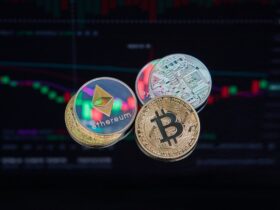In the realm of Understanding Blockchain Ecosystems, picture a thriving digital landscape. This landscape is filled with interlinked technologies like smart contracts and tokens, all built on the bedrock of blockchain. It’s a dynamic community where developers, miners, and users interact and contribute. Just like a natural ecosystem, it’s self-sustaining and evolving. The beauty lies in its decentralization – no single entity has control. Instead, power is spread across the network. From finance to gaming, this ecosystem is leaving its footprints in numerous industries, revolutionizing them with security and transparency. It’s a brave new world out there!
The Emergence of Blockchain
In the late 1970s, the initial sparks of blockchain flickered with cryptographic algorithms. Fast forward to 2008, an enigmatic figure, Satoshi Nakamoto, ignited the flame that set the tech world ablaze with the introduction of blockchain as the backbone of Bitcoin. Like a trusty Swiss Army knife, this transparent and decentralized marvel is now carving out revolutions in various industries. From finance to supply chains, blockchain has become synonymous with innovation and security. We’re truly riding the wave of a groundbreaking era!
What is Blockchain?
Have you ever wondered what the buzzword “Blockchain” is all about? Imagine a digital ledger, similar to an old-fashioned accounting book, but this one is shared across a network of computers and is almost impossible to alter. Pretty cool, huh? Blockchain is the tech behind this, and it’s altering the face of numerous industries.
Historical Background
Let’s take a trip down memory lane. The origins of blockchain technology can be traced back to the late 1970s and 1980s with the development of cryptographic algorithms. However, it wasn’t until 2008 that the first blockchain as we know it today was conceptualized by an anonymous person or group known as Satoshi Nakamoto. What’s the big deal about this? It laid the foundation for Bitcoin, the first cryptocurrency. A true game-changer!
Core Components of Blockchain
The core components of blockchain technology are crucial in understanding how it functions. These components work together to ensure transparency, security, and decentralization which are the hallmarks of this technology. Here they are:
- Decentralization: Traditional systems usually store data in centralized servers. Decentralization, on the other hand, ensures that the blockchain data is not stored on a single central server but across a network of nodes or computers. Imagine having a notebook that thousands of people possess. If someone makes an alteration, everyone can see it. Decentralization thus increases security and reduces the risk of data manipulation.
- Immutable Ledger: One of the distinguishing features of blockchain is immutability. Once data has been written to a blockchain, it is very difficult to change. Think of it like a digital cement: once it’s dry, it can’t be altered. This ensures that transactions can be trusted and the history of the ledger is solid.
- Cryptography: This is the backbone of security in blockchains. Cryptography is used for securely connecting and recording transactions on the ledger. Imagine sending a postal mail that only the recipient can open with a special key. This keeps the information safe during transit. In the same way, cryptography ensures that the information in a blockchain is only visible and accessible by parties involved in the transaction.
- Consensus Algorithms: This is a technique used to achieve agreement on a single data value among distributed systems and processes. Think of consensus algorithms as a democratic process. In a blockchain, they are used to agree on the validity of transactions. Popular consensus algorithms include Proof-of-Work and Proof-of-Stake.
- Smart Contracts: These are self-executing contracts with the terms directly written into lines of code. The contracts execute themselves when set conditions are met. Imagine a vending machine, which releases an item once you insert the correct amount of money; similarly, smart contracts execute the terms of the contract automatically when conditions are met.
- Tokens: Tokens are a representation of a particular asset or utility. In blockchains, these can represent any assets that are fungible and tradable, including commodities. Think of tokens like the chips at a casino, which represent money but can be used in a variety of games.
- Blocks and Chains: At its most basic level, a blockchain is composed of a series of ‘blocks’ linked together in a ‘chain’. Each block contains a list of transactions. Imagine a chain of blocks as a series of containers on a cargo ship, where each container holds valuable items. In blockchain terms, these items are digital pieces of information.
Blockchain Ecosystems and Industries
Blockchain technology is like a digital ledger, but imagine if this ledger didn’t belong to a single entity but was shared among a network of participants. Now, this technology is no longer confined to the realm of cryptocurrencies. It’s permeating various industries, revolutionizing how they operate. Let’s take a closer look at some of these industries and how they’re benefiting from blockchain ecosystems.
Finance and Cryptocurrency
The financial sector has been the first one to embrace blockchain technology. It’s almost synonymous with cryptocurrencies like Bitcoin. But did you know it’s more than just cryptocurrencies? It’s revolutionizing the way transactions are conducted, minimizing fraud and reducing costs.
Supply Chain Management
Ever wondered how the goods you order online reach your doorstep? Blockchain technology in supply chains increases transparency, efficiency, and accountability. It’s like tracking your order in real-time but on a gigantic, global scale.
Online Gaming and Live Casinos
Isn’t it thrilling when you can experience the ambience of a casino, all without leaving the comfort of your home? Well, that’s what online gaming and live casinos have brought to the table. The online gaming industry has seen a massive boom in recent years, and live casinos have become a significant part of it. These platforms offer real-time casino experiences, complete with live dealers, real players, and the adrenaline rush of placing a bet. It’s like carrying a little bit of Vegas in your pocket! But what makes it even more revolutionary is the integration of technology like blockchain. It amplifies transparency, fairness, and security, making games like Plinko https://plinkogameonline.com/ even more exciting. Whether you’re a poker enthusiast or a slot machine lover, live casinos offer a world of entertainment at your fingertips, turning the virtual world into a real-life casino floor.
Future of Blockchain Ecosystems
Imagine a world where technology empowers us to trade, interact, and secure our data with confidence and transparency. Well, welcome to the future of blockchain ecosystems! Just as the internet revolutionized the 21st century, blockchain is now poised to redefine how we view trust and collaboration. So, buckle up and let’s explore what the future holds for blockchain ecosystems.
Innovations and Trends
Blockchain is still young and full of potential. From self-driving cars to voting systems, the possibilities are endless. Are you ready for a world where you can rent your car to a stranger securely, or cast your vote with the click of a button?
Potential Challenges
However, every rose has its thorns. Issues like scalability, energy consumption, and regulatory hurdles could potentially hinder blockchain’s growth. But like any robust technology, with innovation and dedication, these challenges can be overcome.
Conclusion
Blockchain ecosystems are undoubtedly transforming the way we perceive and interact with various industries. From finance to gaming, its applications are vast and its potential, boundless. Are you excited to be a part of this blockchain revolution?









